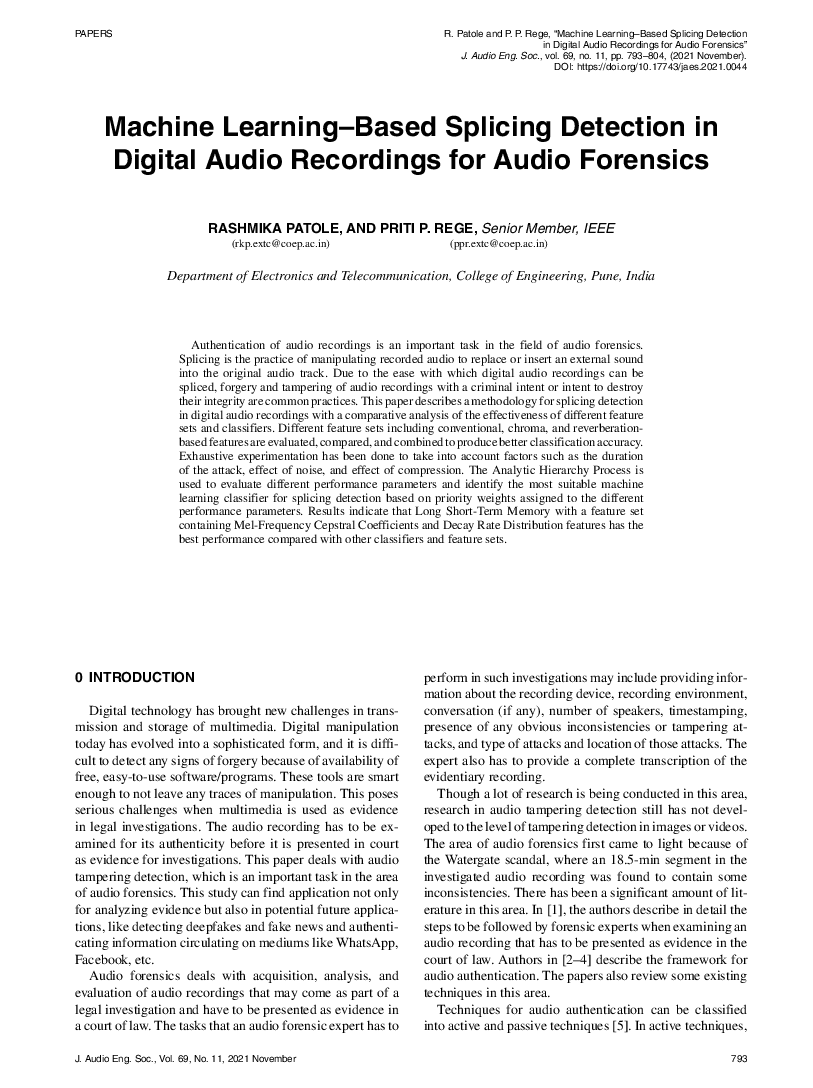Home / Publications / E-library page
You are currently logged in as an
Institutional Subscriber.
If you would like to logout,
please click on the button below.
Home / Publications / E-library page
Only AES members and Institutional Journal Subscribers can download
Authentication of audio recordings is an important task in the field of audio forensics. Splicing is the practice of manipulating recorded audio to replace or insert an external sound into the original audio track. Due to the ease with which digital audio recordings can be spliced, forgery and tampering of audio recordings with a criminal intent or intent to destroy their integrity are common practices. This paper describes a methodology for splicing detection in digital audio recordings with a comparative analysis of the effectiveness of different feature sets and classifiers. Different feature sets including conventional, chroma, and reverberation-based features are evaluated, compared, and combined to produce better classification accuracy. Exhaustive experimentation has been done to take into account factors such as the duration of the attack, effect of noise, and effect of compression. The Analytic Hierarchy Process is used to evaluate different performance parameters and identify the most suitable machine learning classifier for splicing detection based on priority weights assigned to the different performance parameters. Results indicate that Long Short-Term Memory with a feature set containing Mel-Frequency Cepstral Coefficients and Decay Rate Distribution features has the best performance compared with other classifiers and feature sets.
Author (s): Patole, Rashmika; Rege, Priti P.
Affiliation:
Department of Electronics and Telecommunication, College of Engineering, Pune, India; Department of Electronics and Telecommunication, College of Engineering, Pune, India
(See document for exact affiliation information.)
Publication Date:
2021-11-06
Import into BibTeX
Permalink: https://aes2.org/publications/elibrary-page/?id=21530
(746KB)
Click to purchase paper as a non-member or login as an AES member. If your company or school subscribes to the E-Library then switch to the institutional version. If you are not an AES member Join the AES. If you need to check your member status, login to the Member Portal.

Patole, Rashmika; Rege, Priti P.; 2021; Machine Learning--Based Splicing Detection in Digital Audio Recordings for Audio Forensics [PDF]; Department of Electronics and Telecommunication, College of Engineering, Pune, India; Department of Electronics and Telecommunication, College of Engineering, Pune, India; Paper ; Available from: https://aes2.org/publications/elibrary-page/?id=21530
Patole, Rashmika; Rege, Priti P.; Machine Learning--Based Splicing Detection in Digital Audio Recordings for Audio Forensics [PDF]; Department of Electronics and Telecommunication, College of Engineering, Pune, India; Department of Electronics and Telecommunication, College of Engineering, Pune, India; Paper ; 2021 Available: https://aes2.org/publications/elibrary-page/?id=21530
@article{patole2021machine,
author={patole rashmika and rege priti p.},
journal={journal of the audio engineering society},
title={machine learning--based splicing detection in digital audio recordings for audio forensics},
year={2021},
volume={69},
issue={11},
pages={793-804},
month={november},}